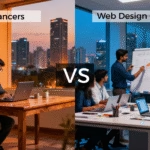Effectual website design should meet its deliberate function by conveying its particular message which simultaneously engaging the visitor. Several factors such as reliability, shades, typography, imagery, simplicity, and functionality contribute to good website design.
Numerous key factors were considerable while designing a website.
A well-designed website can help build faith and direct visitors to take measure. Building a great user experience involves making sure your website design is optimized for usability (form and aesthetics) and how easy is it to use (functionality).
Here are some approaches that will assist you when assessing your next web project.
1. WEBSITE SENSE
Your website needs to acclimate the requirements of the user. Having an explicit intention on all pages will enable the user to interact with what you have to offer. First, decide the goal of your website. There are many sectors in designing a website. Like providing valuable information, business, entertainment, e-commerce, education, edutainment, etc.
There are many different purposes that websites may have but there are core intentions standard to all websites;
- Expressing Expertise
- Creating Your Reputation
- Generating Leads
- Sales and After Care
2. SIMPLICITY
Simplicity is the finest form to go when considering the user knowledge and the usability of your website. Here are some of the ways to achieve simplicity through design.
Colour
Colour has the ability to convey messages and prompt emotional responses. Discovering a colour palette that matches your brand will entitle you to exploit your client’s manners towards your brand. Keep the colour selection confined to less than 5 colours. Tempting colour combinations increase customer attention and make the user feel good.
Type
Typography plays vital role on your website. It controls attention and operates as the optical interpretation of the brand voice. Typefaces should be readable and only use a maximum of 3 different fonts on the website.
Imagery
Imagery is visual element used within communications. It includes photography, illustration, video and all kinds of graphics. All imagery should be explicit and find the spirit of the company and act as the epitome of their brand personality. Most of the initial information we consume on websites is visual as a first impression. It is important that high-quality photographs are used to form an impression of professionalism and credibility in the visitors’ minds.
3. NAVIGATION
Navigation is the path of rectifying system used on websites where visitors interact and encounter what they are looking for. Website navigation is key to retaining visitors. If the website navigation is incoherent to the visitors, then will find what they need elsewhere. Keeping navigation simple, reflexive and compatible on every page is key.
4. F-SHAPED PATTERN READING
The F- based design is the most standard way visitors examine text on a website. There is a study where eye-tracking studies records says that most of what people see is in the top and left areas of the screen. The F shaped layout imitates our natural way of reading in the left to right and top to bottom. An effectively ranked website will function with a reader’s natural pattern of reviewing the page.
5. VISUAL ORDER
Visual order is the sequence of segments in hierarchy of importance. This is accomplished either by size, colour, imagery, contrast, typography, whitespace, texture and style. One of the most vital functions of visual order is to establish a focal point; this offers visitors where the most important information is.
6. CONTENT
An effective website has both prominent design and significant content. Using prominent language great content can attract and influence visitors by flipping them into customers.
7. GRID BASED LAYOUT
Grids support the structure of your layout and keep your content organised. The grid helps to align segments on the page and maintain to be cleaned. The grid-based layout organizes content into a clean strong grid structure with columns, sections that line up and feel proportional and impose order and results in an aesthetically attractive website.
8. LOAD TIME
Waiting for a website to load will renounce visitors. Nearly half of web visitors anticipate a site to load in 2 seconds or less and they will potentially leave a site that isn’t loaded within 3 seconds. Optimising picture sizes will aid load your site quicker.
9. MOBILE FRIENDLY
People now a days like using portable versions like mobile, laptop, tab.
Most of the people are using their mobile phones or other gadgets to browse the web. Building website layout might vary for different devices. It is important to consider making your website with a responsive layout where your website can revise to different screens.













